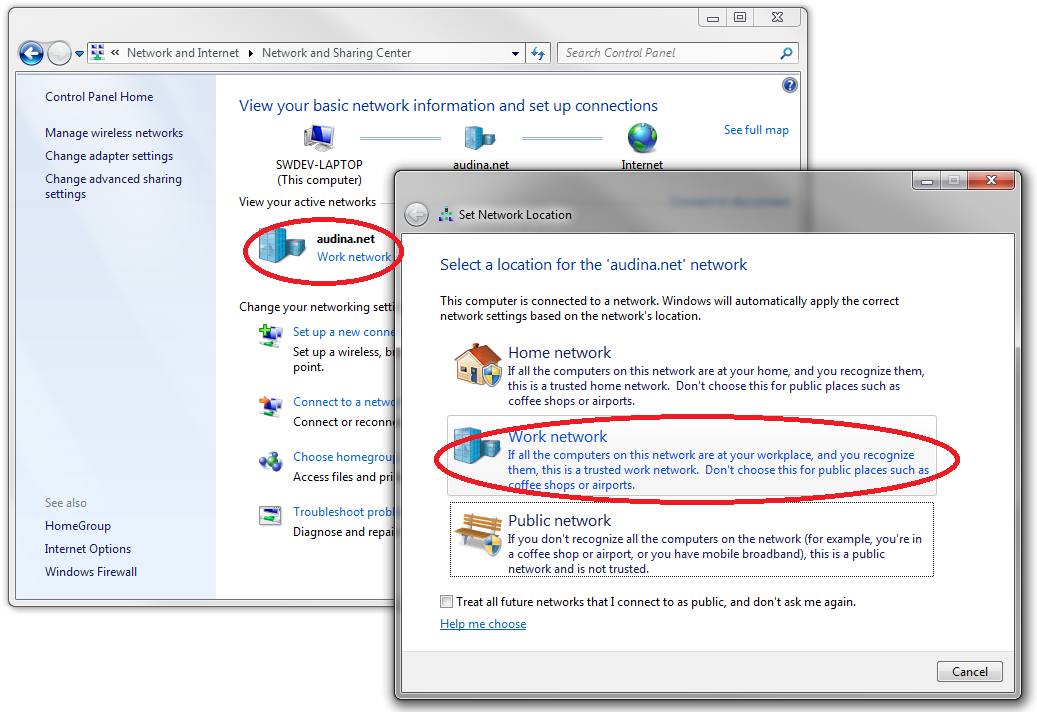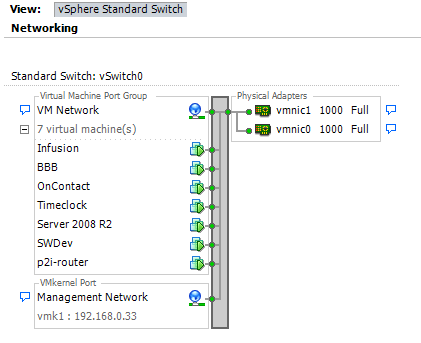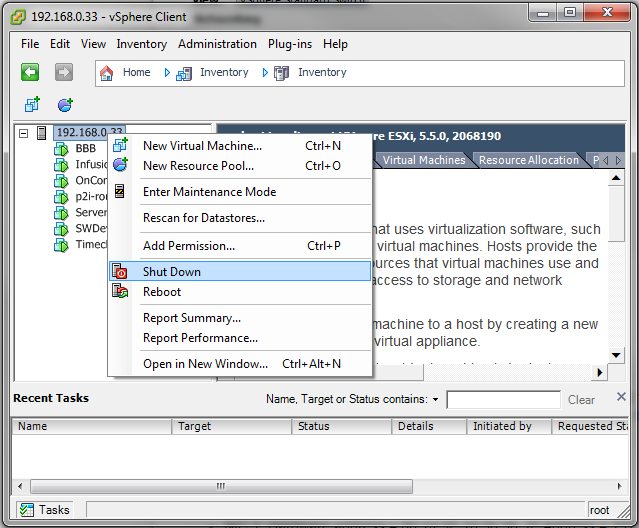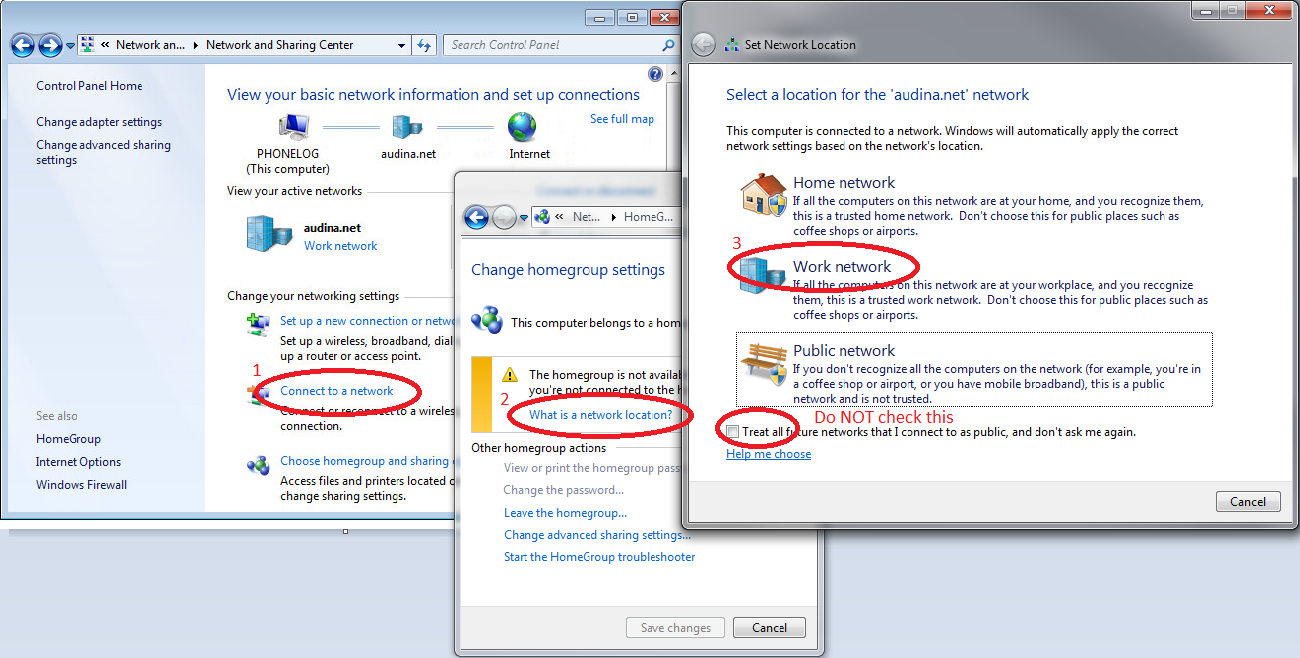This is an old revision of the document!
ESXi Servers (VMware)
We are using a VMware hypervisor - ESXi version 5.5.0 to host all servers. The license below is good for up to 6 CPUs.
Serial Number(s) for VMware vSphere 5 Essentials PLUS for 6 CPU(s):
NH0AP-45L53-58R4N-00AR0-8X755
Virtual Machine Hosts (VMhosts)
- VMHOST1: 192.168.0.33
VMHOST2: 192.168.0.34 (Management Interface)- VMHOST4: 192.168.0.35
The Management Interface IP address must be setup to configure the ESXi host remotely.
Remote Administration
Each VM host can be monitored and managed from a browser by making use of VMware's vSphere HTML 5 Web Client. This interface runs on the host/hypervisor directly. It can be accessed from the links below.
| Host | IP Address | VM Management Link |
|---|---|---|
| VMHost1 | 192.168.0.33 | https://vmhost1.audina.net/ui/ |
| | | https://192.168.0.34/ui/ |
| VMHost4 | 192.168.0.35 | https://vmhost4.audina.net/ui/ |
Sometimes this package will prompt you to update. In most cases that update will fail. When it does you'll see an error message with a link to the package that should have downloaded. To manually install the update follow the instructions below:
- Copy the URL from the error message or alternatively, download the update package and use an SCP/SFTP client to push the package to the host.
- Under Host click
Manage, then clickPackagesand finally clickInstall Update - Paste the previously copied URL or the datastore path you placed the downloaded package in and click
Update
VMHOST4 (Main Host)
This is the main host running the important servers.
- IP Address = 192.168.0.35
VMHOST1 (Nakivo Backup Virtual Machine)
This host backs up all other virtual machines to itself. See more details here.
- IP Address = 192.168.0.33
Host Shutdown
For system reboots/shutdowns, make sure to follow these steps:
- Shutdown each individual virtual machine. Do not use VMware's basic tasks, but use the virtual machine console and login to the server OS to shutdown safely.
- Shutdown or reboot VMware host.
Host Startup
At system start, perform these steps:
Login totimeclockserver, and verifyapacheandPCEntry.exeare running.- Login to
Server20081server, and verify OfficeWatch app, Unifi controller and Timeclock Middleware are running.
Note: It's possible that the network location setting is incorrect. This manifests in subtle network connectivity changes because this setting is what tells the firewall what traffic to block. It is imperative that this is set to Domain network or Work (not Home or Public). Control Panel > Network and Internet > Network and Sharing Center 
Configuring ESXi Firewall
The ESXi firewall contains a number of preconfigured services that can be enabled. If the service you need to enable isn't listed there isn't an interface to do that on the vSphere Client, you must SSH into the host to add it.
Follow the instructions below or see this article on VMWare's site. Creating custom firewall rules in VMware ESXi 5.x (2008226)
To manually add a service to the firewall's list of services:
- Backup the original firewall service list which is located at /etc/vmware/firewall/service.xml
- Change permissions to allow editing service.xml
chmod 0644 /etc/vmware/firewall/service.xml
- Add the service by opening service.xml with vi and modifying the file following the examples already in the file
- Set the file permission back to default
chmod 1444 /etc/vmware/firewall/service.xml
- Refresh the firewall
esxcli network firewall refresh
Note: This file may be overwritten on reboot.
VMware Remote Console
If you have the VMware Remote Console application installed, you can access any virtual machine through a remote desktop-like interface. At the Windows Run prompt:
vmrc://[username]@[host ip]/?moid=[vm moid]
You can install the application from:
\\SERVER20081\Documents and Settings\Software Installation Backup\VMware-VMRC-9.0.0-4288332.msi
These are the available hosts and virtual machines:
| Host | IP Address | VM ID Link |
|---|---|---|
| VMHost1 | 192.168.0.33 | https://192.168.0.33/mob/?moid=ha-folder-vm |
| | | https://192.168.0.34/mob/?moid=ha-folder-vm |
| VMHost4 | 192.168.0.35 | https://192.168.0.35/mob/?moid=ha-folder-vm |
| Host | Virtual Machine | Remote Console Link | VM Screenshot Link |
|---|---|---|---|
| VMHost4 | Infusion | vmrc://192.168.0.35/?moid=11 | https://192.168.0.35/screen?id=11 |
| VMHost4 | Server20081 | vmrc://192.168.0.35/?moid=13 | https://192.168.0.35/screen?id=13 |
| VMHost4 | SWDev | vmrc://192.168.0.35/?moid=9 | https://192.168.0.35/screen?id=9 |
| VMHost4 | p2i-router | vmrc://192.168.0.35/?moid=10 | https://192.168.0.35/screen?id=10 |
| VMHost4 | OnContact | vmrc://192.168.0.35/?moid=12 | https://192.168.0.35/screen?id=12 |
| VMHost4 | www | vmrc://192.168.0.35/?moid=8 | https://192.168.0.35/screen?id=8 |
| VMHost1 | Nakivo Backup | vmrc://192.168.0.33/?moid=39 | https://192.168.0.33/screen?id=39 |



